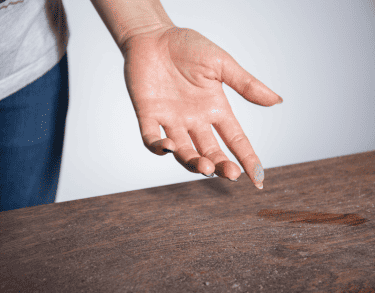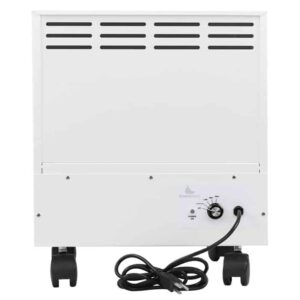Have you ever conducted the white finger glove test to your home to determine if your deep cleanings are really doing the job to remove those pesky and irritating dust and dander allergens that can collect and accumulate on the surfaces in this environment? It may seem like you just cleaned only to find more and more traces of these allergens developing within your home, and they can even lead to the exacerbation of many health conditions in those occupants exposed to them in the airspace, especially those who suffer from allergies to these common household allergens. The composition behind dust and dander are fine particles that when inhaled or ingested into the human body will begin to trigger an allergic response within the immune system, which identifies the allergens as a foreign invader inside the body triggering the known health responses of an allergy attack.
Dust and dander allergies are two of the most common allergies that many people experience and deal with inside of their homes, as these types of allergens can easily be produced and collected onto surfaces in your home like bedding, upholstery, and other surfaces. For those people who work diligently to rid and minimize their homes of these allergens with frequent cleaning maintenance, they may be surprised to learn just how high the dust and dander levels may still be in this indoor environment. Therefore, integrating air quality and other cleaning practices into your home’s indoor airspace may be the much-needed addition to your eradication process of these pesky allergens moving forward.
In this article we are going to discuss everything to know about dust and dander allergies including what dust and dander are in the environment, how they are produced, what kind of allergic symptoms they will create, and how to control the levels of these allergens in your indoor environment.
What is Dust and Dander
The home is a safe oasis that many people identify as a secured environment that does not pose any threats or adverse impacts to human health. However, your home can be a breeding ground for non-threatening but irritating allergens that can strike up allergic-symptoms in the body for those who are sensitive to them if exposure occurs. Dust and dander are two of the most common household allergens that can be found within this type of indoor environment, and they are also the most common allergens that a vast majority of people who suffer from allergies are allergic to in the environment. According to WebMD, an estimated 50 million Americans are allergic to everything from dust and dander, to mold and mites.
 Dust is composed of fine particles of solid mater that can consist of pollen, human and animal hairs, textile fibers, paper fibers, minerals from outdoor soil, human skin cells, and other materials found within the environment. Household dust and dust mites are present in almost any environment where humans live due to the particles that are produced and released from both the skin of these individuals and from their activities within this environment. As these dust particles form in the environment, they can begin to accumulate and eventually lead to the development of allergic-symptoms in those exposed to the dust indoors.
Dust is composed of fine particles of solid mater that can consist of pollen, human and animal hairs, textile fibers, paper fibers, minerals from outdoor soil, human skin cells, and other materials found within the environment. Household dust and dust mites are present in almost any environment where humans live due to the particles that are produced and released from both the skin of these individuals and from their activities within this environment. As these dust particles form in the environment, they can begin to accumulate and eventually lead to the development of allergic-symptoms in those exposed to the dust indoors.
In addition, household dander is composed of tiny, even microscopic flecks of skin shed by cats, dogs, rodents, birds, and other animals with fur or feathers. These tiny bits of skin can cause reactions in people who are allergic to these triggers. Dander is also produced from the proteins found in the saliva, urine, and feces of cats and dogs. The most common allergies are caused by Fel d I protein from cats and the Can f I and Can f II proteins from dogs.
What Causes Dust in a House
When it comes to what could be causing the production and accumulation of dust and other allergens like dander in a home, there can be a variety of causes – and some of these causes of dust may surprise you! As we discussed earlier, dust and many other forms of allergens are known for settling onto surfaces in the home, specifically fabric surfaces like upholstery, carpeting, and furniture. In addition, though dust will also be drawn to areas like your air filtration system where the HVAC air filter will capture those airborne dust into the filter material, as well as in air ducts that may leak collect dust and dust mites into the air circulation of the home.
Below we are going to discuss the top three causes of dust emission in a home.
- Carpeting: Carpet flooring is a popular option among most homeowners and commercial buildings due to its cheap price, noise reduction capabilities, and easy to clean nature. However, what if you knew that carpeting is one of the main culprits behind dust collection in an indoor environment? Dust is attracted to fabric and the surface of carpeting is an ideal area for these allergens to settle into. Many will recommend that you frequently vacuum the carpeting in your home to remove this build-up of dust, but this is a major fallacy that can actually worsen the dust situation in the home. Therefore, it is best to utilize a HEPA vacuum that is designed to filter out fine particulate matters from the air of this indoor environment.
 HVAC Air Filters: The decision you make when it comes to the type of HVAC filter you have installed into your air handling system is something that can drastically impact the accumulation and build-up of dust in this system – which ultimately will lead to an airborne dust issue. The cheaper, fiberglass filters will do very little to catch smaller particles like dust and when these dust particles go past the filter, they will get into the AC evaporator coil allowing it to get dirty and pushing the airborne dust into the recirculating air of the home. Thus, it is necessary to utilize a high-grade, more effective HVAC filter for dust and dust mite removal.
HVAC Air Filters: The decision you make when it comes to the type of HVAC filter you have installed into your air handling system is something that can drastically impact the accumulation and build-up of dust in this system – which ultimately will lead to an airborne dust issue. The cheaper, fiberglass filters will do very little to catch smaller particles like dust and when these dust particles go past the filter, they will get into the AC evaporator coil allowing it to get dirty and pushing the airborne dust into the recirculating air of the home. Thus, it is necessary to utilize a high-grade, more effective HVAC filter for dust and dust mite removal.- Leaking Air Ducts: The air ducts inside of a home could be potentially sucking in dust from areas of your home like your attic and other dusty places and distributing them throughout your house. This can be a major contributing cause to dust formation in the indoor environment that can lead to allergies in those occupants exposed to this indoor allergen.
Can You Be Allergic to Dust and Dander?
If you begin to notice that when you are inside of your home that an unmistakable bout of allergic-symptoms start to take place inside of your body, this may be a big alarm that you have a dust and dander allergy that is magnified when inside your home. According to the American College of Allergy, Asthma, & Immunology, people with dust mite allergies – including dust allergies, will often suffer most inside their homes or in other people’s homes. The tiny allergens like dust and dander will freely and easily float within the airspace of an indoor environment and will become effortlessly ingested/inhaled into the human body which will begin the allergy symptoms. These types of allergies can happen all year round in a condition which is known as perennial allergic rhinitis.
Dust and dander allergies will commence when an individual(s) become exposed to these allergens and they begin the process of entering into the human body. The body’s immune system is responsible for controlling how a person’s body will defend itself from foreign invaders that may pose a risk to your health. The immune system will identify when an allergen like dust and dander enter into the body and immediately classify it as a foreign invader. When this occurs, the immune system will begin to overreact by producing allergic antibodies called Immunoglobulin E (IgE). These specific antibodies will travel to the cells that release chemicals spiking an allergic reaction – this type of reaction will produce symptoms such as sneezing, stuffiness, a runny nose, or itchiness in the nose, roof of the mouth, throat, eyes, or ears.
Dust Allergy Symptoms
 Dust allergies have been commonly compared to that of pollen allergies, a type of allergy that is provoked from exposure to these airborne allergens in the environment. Often times, when we suffer from an allergy to a specific type of allergen it will be the mission of this individual to avoid the allergen in their environments as much as possible. However, when it comes to dust and dander it is hard to avoid these allergens inside of a home due to the nooks and crannies that these allergens can easily fall into inside of this environment.
Dust allergies have been commonly compared to that of pollen allergies, a type of allergy that is provoked from exposure to these airborne allergens in the environment. Often times, when we suffer from an allergy to a specific type of allergen it will be the mission of this individual to avoid the allergen in their environments as much as possible. However, when it comes to dust and dander it is hard to avoid these allergens inside of a home due to the nooks and crannies that these allergens can easily fall into inside of this environment.
If you are exposed to dust and dander allergies in your personal indoor environment or any commercial indoor space, the most common symptoms that you may begin to experience from the dust allergy will include the following, according to WebMD;
- Red, itchy, watery eyes
- Itchy, runny, stuffy nose
- Sneezing
- Congestion
- Rash
- Difficulty breathing
- Hives
How to Control Indoor Dust and Dander
For those individuals who suffer from allergies and asthma, controlling exposure to these allergens will begin at home – a place where people are most exposed to allergens like dust and dander. Locating the sources of these allergens in the home, along with finding solutions to mitigating and controlling the dust and dander levels inside the space is important to restoring your indoor environment to a healthier, allergen reduce space. Many homeowners who struggle with the sometimes-debilitating health condition of allergies are incorporating air quality solutions into the environment to help remove airborne allergens from the airspace.
How to get rid of dust floating in the air? Air quality solutions like air purifiers and HVAC filters are two of the most common solutions that are placed into a home or other commercial environment to rid allergens from the air. Air purifiers are air filtration devices that are designed to filter the indoor air of allergens through the use of different filtration technologies utilized in the different types of air purifiers. In addition, HVAC filters can also be used and integrated into an air handling system to work to capture these fine particulate matter allergens from the air both efficiently and quickly.
Air Purifier for Dust and Dander Levels
 The EnviroKlenz Air Purifier is a patented, one-of-a-kind air purifier that uses a proprietary earth mineral technology that captures, contains, and neutralizes a broad spectrum of noxious and toxic chemicals and odors from the air, such as VOCs and other chemicals. In addition to the proprietary earth mineral EnviroKlenz Air Cartridge, the EnviroKlenz Air Purifier also contains a hospital-grade HEPA filter that is capable of filtering out fine particulate matter larger than 0.3 microns in size at a 99.99 percent efficiency. This HEPA filter allows for the EnviroKlenz Air Purifier to easily capture and remove dust and dander allergens from the air, containing them onto the thick media filter of the HEPA.
The EnviroKlenz Air Purifier is a patented, one-of-a-kind air purifier that uses a proprietary earth mineral technology that captures, contains, and neutralizes a broad spectrum of noxious and toxic chemicals and odors from the air, such as VOCs and other chemicals. In addition to the proprietary earth mineral EnviroKlenz Air Cartridge, the EnviroKlenz Air Purifier also contains a hospital-grade HEPA filter that is capable of filtering out fine particulate matter larger than 0.3 microns in size at a 99.99 percent efficiency. This HEPA filter allows for the EnviroKlenz Air Purifier to easily capture and remove dust and dander allergens from the air, containing them onto the thick media filter of the HEPA.
By placing this air purifier in your home, you can easily, efficiently, and rapidly restore your indoor environment back to normal pollutant levels. Also, with the machines capability to remove a broad spectrum of allergens this can help to alleviate most dust and dander allergies symptoms.
Article Sources:
- WebMD: Indoor Allergy Triggers (link)
- American College of Allergy, Asthma, & Immunology (ACAAI): Dust Allergy (link)
- WebMD: Dust Allergies (link)
Mobile Air System
✓ Patented earth mineral technology works to attack VOCs and break them down on a compound level
✓ No chemicals or masking agents
✓ Will not release any chemicals back into your environment
✓ Safer and faster at removing VOC’s than traditional carbon filters and PECO air purifiers








